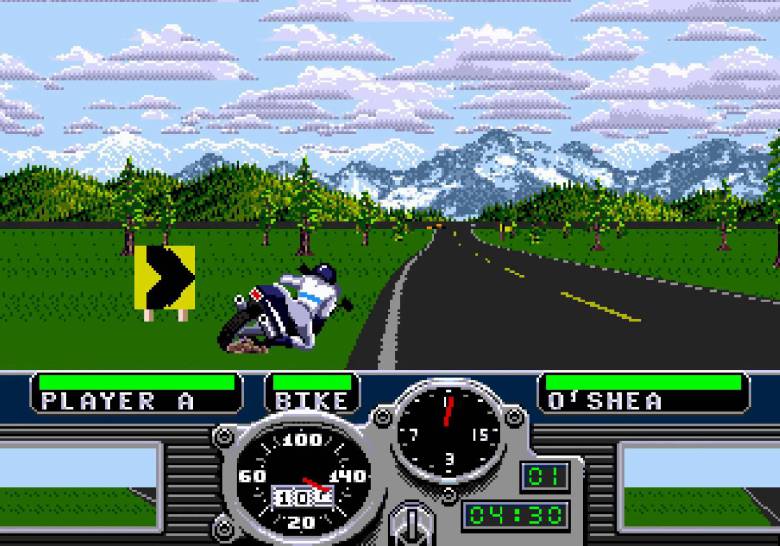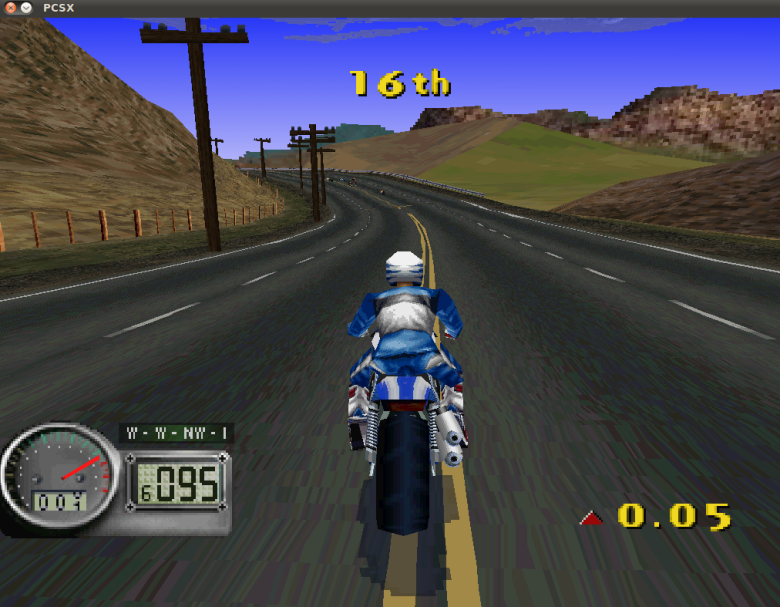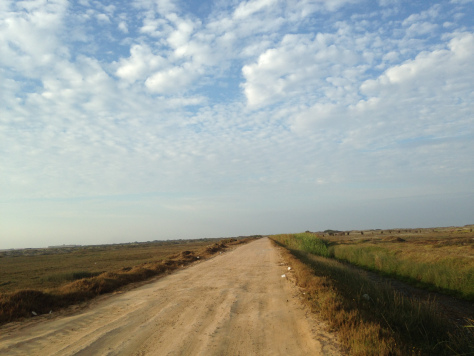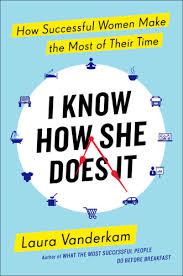Just 0.2 miles to go until the Peninsula finish line. First place, $3,750 prize money and finally enough in the bank to buy that Diablo 1000 I’d been lusting after since day one.
Viper appears in my rear-view mirrors. I dummy left and swerve right. There’s a slow-moving car in the outside lane. If I time this just right, I can force him out and into its path, and then I’m the one surrounded by swooning leather-jacketed babes while he eats a not inconsiderable amount of asphalt.
I don’t see the swinging baseball bat until it connects with my visor. Crack! My stamina is already on fumes, chipped away by that persistent highway patrolman a few miles back and that moment with the sudden hill and the family sedan I ploughed into.
As I cartwheel one direction and my bike in another, close enough to the finish to see the two-frame animations of the waiting crowds, I have enough time to see Viper streak over the line before another dozen bikers scream past. 13th place is my reward for surviving almost ten miles of undulating highways.

And if that vignette doesn’t make you want to immediately jump on your bike and try again, then you’ll never understand the unique appeal of Road Rash. If you want to put Viper in his place next time out, then let me take you on a journey back to the flannel-tinted era of 1991…
It’s strange to think of a time when Electronic Arts made solid games with minimum evil, but the arrival of Road Rash in September 1991 on the Sega Mega Drive created a fresh fusion of styles within the always-crowded driving genre. A motorcycle racing game where you could punch, kick and attack your fellow riders with baseball bats and nunchucks? Where shunting an opponent into oncoming traffic was actively encouraged? Add a splash of Cannonball Run-inspired illegality and you have what co-lead designer Randy Breen called “more of an entertaining game than a pure driving simulation.”
The first instalment tasked you, Player A (or ‘Alex Player’ as one novelisation called the player), with competing in a series of illegal road races along the California coastline against 19 other hardy bikers, each with their own personality (and rudimentary AI to match). Finish 4th or higher and you’d get both a slab of prize money and entry to the next race, with the chance to upgrade/repair your bike, buy a new model entirely or pay off fines if the ol’ CHiPs got their gloved hands on you.
Your relationships with these riders could be affected by in-game actions – some were generally favourable towards you and would treat you more fairly on the road, while others were textbook villains, bodyblocking you and kicking like mules if you so much as entered their postcode. We all wanted Natasha to like us, and were mortified if her cheery expression turned to an angry scowl after that unfortunate incident with the cow we honestly hadn’t seen until we nudged her into it. Some guys like Sledge or Roz would offer tips, and some racers like Kakana would benignly state “me got no beef with you”, whatever that means.
It was the Amiga home port in 1994 where I kicked my first Biff off the crest of a hill into a billboard (because we all hated Biff), by which point Road Rash II (1992) had landed, this time a Mega Drive exclusive. Now we had two-player split screen, races all across the US of A, more bikes, nitro boosts and the iconic bike chain as a fresh weapon to leave some interesting dents in your opposition’s prized rides.
A slew of ports based on the original game (plus a handful of the improvements from the sequel) landed on everything from the PlayStation and PC to more ill-fated consoles like the Saturn and 3DO. Some of these offered different starting characters rather than the faceless Player, added in digitised graphics and cut scenes (some adding an exaggerated, cartoony style that was so achingly 90s I’m surprised it didn’t try to release a solo album), and licensed music. Soundgarden, Therapy?, Monster Magnet and a gaggle of post-grunge also-rans made the menu and loading screens a lot more entertaining, because it took around six seconds of the synthesised engine drone noise in the main game to drive one to insanity.

1995’s Road Rash 3 took the racing international, but again as a Mega Drive exclusive and this time with even more onus on hurting your fellow riders. 1995 was a tricky transitionary period for gaming – the PlayStation was showcasing the possibilities of 3D graphics in a home console for the first time, and in the struggle to keep up we saw game franchises big and small hurriedly convert their style to match. Some succeeded – Road Rash did not.
Road Rash 3D (1998) was a PlayStation exclusive, toning down the violence in favour of the racing but maintaining the arcade-style handling (i.e. a long step from realistic physics) the series was known for. We still had licensed music (with the game prominently featuring three tracks from Sugar Ray, back when they were an actual rock band), but we lost multiplayer and gained a ton of graphical glitches courtesy of the move to 3D. Essentially an update of the 3DO port, it landed to poor reviews and a chorus of disappointment from fans.
It was up to Nintendo 64 exclusive Road Rash 64 (1999) to pull things back in the series’ Nintendo debut, away from the oversight of EA for the first time. With combat back to the forefront, it played as a spiritual successor to Road Rash II, sacrificing graphical fidelity for framerate and on-screen action (unless you had the Expansion Pack plugin to neatly boost the game’s restrictions). Multiplayer was also back, as were Sugar Ray, and for circuits the game employed a clever system of interconnected routes rather than individual locales.
Unfortunately, it didn’t gel as well as hoped, and critical response sat firmly in the ‘fun but meh’ spectrum. Earlier games overcame their shortcomings in graphics and sound through high repeat playability, but by the late 90s gamers were developing high expectations (largely through game publishers marketing campaigns), and so even a decent effort felt lacking when compared to the competition.

All of which brings us to the sixth and final (official) entry in the series to date, Road Rash: Jailbreak (2000), another PlayStation exclusive. You know the drill by now – race, win, punch, boost, don’t get busted. The focus was back on racing over fighting, and while it borrowed Road Rash 64‘s interconnected route system, it added alternate game modes to justify the ‘Jailbreak’ subtitle. Now you were racing fellow gang members for the honour of busting your leader out of jail, (finally) playing as a cop looking to bust some rashers, or even riding sidecar in the frenetic multiplayer battle arenas. Sure, the polygon graphics made this look like Virtua Fighter on wheels, but the game deserves credit for trying some fresh ideas (even with the soundtrack).
Seventeen years later, the mainline series remains dormant despite occasional efforts to revive it. Criterion Games (of the excellent Burnout series) have flirted with a revival, and co-designer of the original trilogy Dan Geisler tried (and failed) to get funding for a revival a few years ago. There are, however, two new contenders to the throne that may yet be what the fans are waiting for: Road Redemption and Road Rage.
Redemption is still in development and available to play Early Access, pulled together by series fan Ian Fisch after seeing other attempts at revivals run out of gas early on. After a successful Kickstarter campaign that raised $173,000 in 2013, the game has undergone several revisions and iterations but is still some way off the final polish it needs to take the lead. It’s still too soon to say if what is essentially a Road Rash fanfic will live up to its obvious potential.
Road Rage takes a more punky aesthetic, casting the player as an up-and-comer in ‘the most insane outlaw motorcycle gang in town’ (sounds delightful already). It’s story-driven, with the player running missions to complete objectives, exploring an open world map (because of course it does – it’ll be announcing ‘radio towers’ next), and of course buying better bikes and bigger sticks to smash people in with. There’s little gameplay footage so it’s hard to get a bead on this one, but what we have seen feels very Grand Theft Auto-inspired. Not necessarily a bad thing. While it sounds like fun, any gamers rightly wary of pre-order culture are best advised to wait and see when it drops late October.
- More





